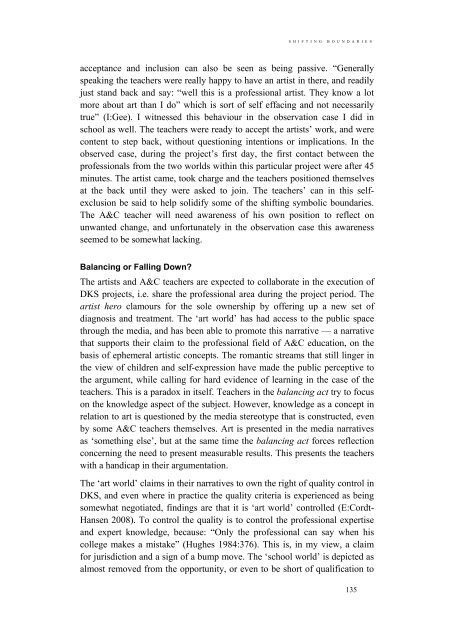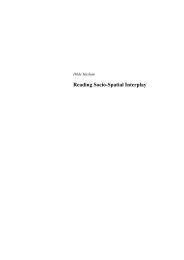CON ⢠TEXT - Arkitektur- og designhøgskolen i Oslo - AHO
CON ⢠TEXT - Arkitektur- og designhøgskolen i Oslo - AHO
CON ⢠TEXT - Arkitektur- og designhøgskolen i Oslo - AHO
- No tags were found...
Create successful ePaper yourself
Turn your PDF publications into a flip-book with our unique Google optimized e-Paper software.
S H I F T I N G B O U N D A R I E Sacceptance and inclusion can also be seen as being passive. “Generallyspeaking the teachers were really happy to have an artist in there, and readilyjust stand back and say: “well this is a professional artist. They know a lotmore about art than I do” which is sort of self effacing and not necessarilytrue” (I:Gee). I witnessed this behaviour in the observation case I did inschool as well. The teachers were ready to accept the artists’ work, and werecontent to step back, without questioning intentions or implications. In theobserved case, during the project’s first day, the first contact between theprofessionals from the two worlds within this particular project were after 45minutes. The artist came, took charge and the teachers positioned themselvesat the back until they were asked to join. The teachers’ can in this selfexclusionbe said to help solidify some of the shifting symbolic boundaries.The A&C teacher will need awareness of his own position to reflect onunwanted change, and unfortunately in the observation case this awarenessseemed to be somewhat lacking.Balancing or Falling Down?The artists and A&C teachers are expected to collaborate in the execution ofDKS projects, i.e. share the professional area during the project period. Theartist hero clamours for the sole ownership by offering up a new set ofdiagnosis and treatment. The ‘art world’ has had access to the public spacethrough the media, and has been able to promote this narrative — a narrativethat supports their claim to the professional field of A&C education, on thebasis of ephemeral artistic concepts. The romantic streams that still linger inthe view of children and self-expression have made the public perceptive tothe argument, while calling for hard evidence of learning in the case of theteachers. This is a paradox in itself. Teachers in the balancing act try to focuson the knowledge aspect of the subject. However, knowledge as a concept inrelation to art is questioned by the media stereotype that is constructed, evenby some A&C teachers themselves. Art is presented in the media narrativesas ‘something else’, but at the same time the balancing act forces reflectionconcerning the need to present measurable results. This presents the teacherswith a handicap in their argumentation.The ‘art world’ claims in their narratives to own the right of quality control inDKS, and even where in practice the quality criteria is experienced as beingsomewhat negotiated, findings are that it is ‘art world’ controlled (E:Cordt-Hansen 2008). To control the quality is to control the professional expertiseand expert knowledge, because: “Only the professional can say when hiscollege makes a mistake” (Hughes 1984:376). This is, in my view, a claimfor jurisdiction and a sign of a bump move. The ‘school world’ is depicted asalmost removed from the opportunity, or even to be short of qualification to135
















